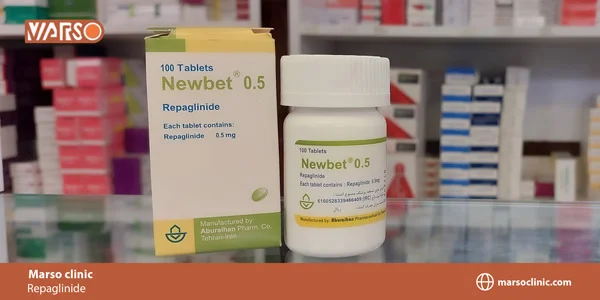General English name: Repaglinide
Brand: Enyglid, Prandin
Application: Type 2 diabetes
what you will read next :
Pharmacological information of rapaglinide
Medication Information: Insulin is a hormone that is naturally made in the body by the pancreas. This helps control blood sugar levels. If your body does not make enough insulin to meet its needs, or if it does not use the insulin it makes effectively, a condition called type 2 diabetes (diabetes mellitus) develops. People with diabetes should be treated to control their blood sugar. This is because effective blood sugar control reduces the negative consequences of diabetes. In some people, changes in diet can control blood sugar levels, but in others, medications such as rapaglinide may be prescribed in addition to the diet.
Repaglinide lowers blood sugar by encouraging the pancreas to produce insulin. It works immediately after a meal and controls blood sugar levels.
Contraindications to repaglinide
- Note the expiration date of the repaglinide medicine and do not take it if the medicine you are taking has expired.
- Never give rapaglinide to anyone else, even if you have the same symptoms.
- Do not take more than the dose of rapaglinide prescribed by your doctor.
- Check for rapaglinide drug interactions and be sure to tell your doctor what other medications you are taking.
Drug interaction with rapaglinide
Drug interactions may alter drug performance and increase the risk of serious side effects. Make a list of all the medicines (including prescription / over-the-counter and herbal medicines) you use and share them with your doctor and pharmacist. Do not change the dose of your medicine without consulting your doctor or stop taking the medicine.
NPH insulin may interact with rapaglinide.
Beta-blockers (such as metoprolol, propranolol, glaucoma eye drops such as thymolol) may prevent heart palpitations, which are commonly felt during hypoglycemia. Other symptoms of low blood sugar, such as dizziness, hunger, or sweating, are not affected by these medications.
Many medications can affect your blood sugar levels (for example, corticosteroids (such as prednisone), psychotropic drugs (such as olanzapine), fluoroquinolone antibiotics (such as ciprofloxacin)), and difficulty controlling your blood sugar. Before you start, stop, or change any medication, talk to your doctor or pharmacist about how to take the medicine (the medicine that works on your blood sugar level). Check your blood sugar levels regularly and consult your doctor if you notice a sudden change in your blood sugar (high or low blood sugar). If you have serious side effects, talk to your doctor about changing your medication dose, exercise program, and diet.
A number of medications affect the removal of rapaglinide from your body and may affect the function of rapaglinide. These include clopidogrel, cyclosporine, gemfibrozil, trimethoprim, azole antifungals (such as itraconazole), macrolide antibiotics (such as erythromycin), rifamycins (such as rifabutin), and St. John’s wort.
Check the labels on all your medicines (such as cough and cold medicines). Because they may contain ingredients (alcohol or sugar) that affect your blood sugar. Talk to your pharmacist about taking rapaglinide.
Tips to consider before taking rapaglinide
Some medications cannot be prescribed under certain conditions, and some medications may be prescribed if additional treatment is needed; Therefore, it is best for your doctor to know the following before taking repaglinide:
- If you decide to have a baby, if you are pregnant, or if you are breast-feeding.
- If you have kidney or liver problems.
- If you are under 18 or over 75 years old.
- If you have an infection or a chronic illness.
- If you are currently taking certain medications. These include all available medicines, whether prescribed or used by your doctor, such as herbal medicines and supplements.
- If you have ever been allergic to a particular medicine.
Possible side effects of repaglinide
All medications, along with their positive effects, can cause unwanted side effects in the body. However, these complications do not occur in all people. Over time, your body will adjust to the new medication and these symptoms will go away, but if the following symptoms persist or become painful, consult your doctor.
Diarrhea, abdominal and stomach pain, sweating, paleness, feeling of hunger, palpitations, feeling of dizziness
Hypoglycemia: Symptoms include chills or anxiety
Talk to your doctor if you have any other symptoms that you think may be due to rapaglinide.
How to store repaglinide
Keep the medicine in a cool, dry place away from heat and direct sunlight.
Keep all medicines out of the reach of children.

